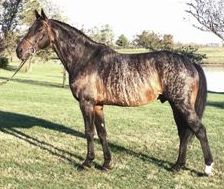Brindle
Brindle is a coat color pattern in animals, particularly dogs, cats, guinea pigs, and sometimes horses. It is characterized by a tiger-stripe or patchy pattern of dark hairs over a lighter background. The brindle pattern is not a specific color, but rather a pattern of coloring which can vary from animal to animal and can include various shades ranging from black, brown, tan, and gold. This pattern is caused by a complex interaction of genetic factors that affect the distribution of melanin and other pigments in the animal's fur.
Genetics[edit | edit source]
The genetics of brindle patterns are complex and involve multiple genes. In dogs, the brindle pattern is often associated with the K locus, where the dominant allele (K^br) codes for the brindle pattern, while the recessive allele (k) does not. However, the expression of the brindle pattern can also be influenced by other genetic factors, including modifier genes that can intensify or dilute the pattern. In cats, the brindle pattern, often referred to as "classic tabby," is controlled by different genes that affect the distribution of pigments in the fur.
Breeds[edit | edit source]
Many dog breeds can exhibit the brindle pattern, including but not limited to the Boxer, Bull Terrier, French Bulldog, and Greyhound. In each breed, the brindle pattern can vary significantly in appearance, from light, almost imperceptible stripes to bold, dark stripes that cover most of the body. In cats, the brindle or classic tabby pattern is common in many breeds and mixed-breed animals. The pattern is particularly notable in breeds like the American Shorthair, British Shorthair, and Maine Coon.
Appearance[edit | edit source]
The appearance of the brindle pattern can vary widely. It typically consists of dark stripes on a lighter background, but the stripes can be narrow, wide, straight, or irregular. The base color of the animal can also affect the appearance of the brindle pattern, with some animals displaying a very subtle brindle that is only visible in certain lighting conditions, while others may have a very distinct and bold pattern.
Care and Grooming[edit | edit source]
Animals with brindle coats do not require any special care or grooming compared to animals with other coat colors. Regular grooming practices that are appropriate for the species and breed are sufficient to maintain the health and appearance of the coat. However, it is important for owners to be aware that the unique pattern of a brindle coat can sometimes make skin conditions or external parasites more difficult to spot.
Cultural Significance[edit | edit source]
The brindle pattern has been admired and sought after in various cultures for centuries, often associated with strength, stealth, and beauty. In some cultures, brindle-coated animals are believed to have special qualities or abilities. The pattern's distinctiveness also makes brindle-coated animals popular in shows and competitions, as well as in advertising and media.
Search WikiMD
Ad.Tired of being Overweight? Try W8MD's physician weight loss program.
Semaglutide (Ozempic / Wegovy and Tirzepatide (Mounjaro / Zepbound) available.
Advertise on WikiMD
|
WikiMD's Wellness Encyclopedia |
| Let Food Be Thy Medicine Medicine Thy Food - Hippocrates |
Translate this page: - East Asian
中文,
日本,
한국어,
South Asian
हिन्दी,
தமிழ்,
తెలుగు,
Urdu,
ಕನ್ನಡ,
Southeast Asian
Indonesian,
Vietnamese,
Thai,
မြန်မာဘာသာ,
বাংলা
European
español,
Deutsch,
français,
Greek,
português do Brasil,
polski,
română,
русский,
Nederlands,
norsk,
svenska,
suomi,
Italian
Middle Eastern & African
عربى,
Turkish,
Persian,
Hebrew,
Afrikaans,
isiZulu,
Kiswahili,
Other
Bulgarian,
Hungarian,
Czech,
Swedish,
മലയാളം,
मराठी,
ਪੰਜਾਬੀ,
ગુજરાતી,
Portuguese,
Ukrainian
Medical Disclaimer: WikiMD is not a substitute for professional medical advice. The information on WikiMD is provided as an information resource only, may be incorrect, outdated or misleading, and is not to be used or relied on for any diagnostic or treatment purposes. Please consult your health care provider before making any healthcare decisions or for guidance about a specific medical condition. WikiMD expressly disclaims responsibility, and shall have no liability, for any damages, loss, injury, or liability whatsoever suffered as a result of your reliance on the information contained in this site. By visiting this site you agree to the foregoing terms and conditions, which may from time to time be changed or supplemented by WikiMD. If you do not agree to the foregoing terms and conditions, you should not enter or use this site. See full disclaimer.
Credits:Most images are courtesy of Wikimedia commons, and templates, categories Wikipedia, licensed under CC BY SA or similar.
Contributors: Prab R. Tumpati, MD




